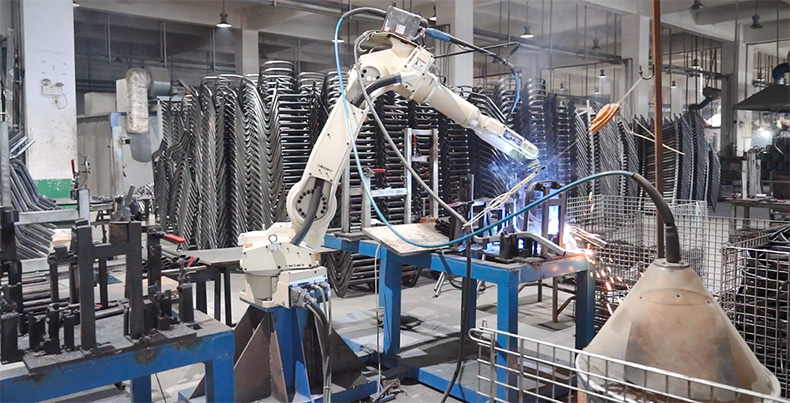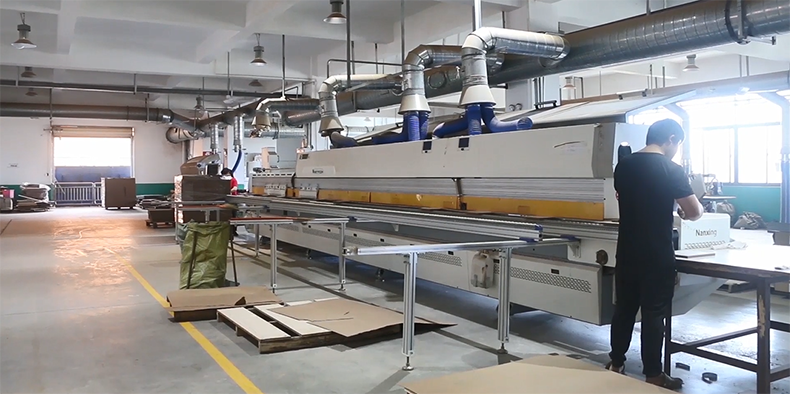- Home
- About Us
- Service
-
Solution
- Kindergarten Classroom
- Primary School Classroom
- Secondary School Classroom
- High School Classroom
- College Classroom
- Training Classroom
- Music Classroom
- Art Classroom
- Lecture Classroom
- Computer Classroom
- Library
- Principal Office
- Administration Office
- Meeting Room
- Reception Room
- Public Area
- Teachers' Office
-
Products
- Case Study
- News
- VR Designs
- Video Center
- JS Lab
- Contact Us

Furniture industry shows a "young state"
2024-08-10 22:00
Put on VR glasses and choose customized furniture plans; use "intelligent manufacturing" equipment to quickly turn design drawings into actual furniture; with the help of cross-border e-commerce, large pieces of furniture have accelerated across the ocean... In recent years, furniture design, production, and sales have Each link such as the furniture industry continues to be refreshed and upgraded, and the furniture industry shows a "young attitude".
Tu Qi, vice chairman and secretary-general of the China Furniture Association, told reporters that furniture companies are targeting new consumer demands, promoting digital transformation, and accelerating the expansion of overseas markets, so that the furniture industry can maintain a positive development trend.
Data released by the National Bureau of Statistics show that from January to May this year, the operating income of furniture manufacturing enterprises above designated size was 252.91 billion yuan, a year-on-year increase of 5.9%; the total profit was 10.81 billion yuan, a year-on-year increase of 18.5%.
1. Focus on new consumption needs
Through product innovation, furniture companies continue to meet and stimulate new consumer demands, revitalizing traditional industries.
Personalized furniture customization has become a hot consumer topic. In front of the cloud design platform of Daxin Home Furnishing Industrial Design Center in Zhengzhou City, Henan Province, a couple born in the 1990s searched for new house plans in the system. After the system rendered them in 10 seconds, thousands of three-dimensional design plans were displayed in sequence. The two put on VR glasses to "immerse themselves" in the new house, "put in" their favorite household items, experience different decoration styles, and choose their favorite decoration plan.
After screening, the two finally chose the new Chinese style plan. After the contract is signed, the personalized design drawings will be optimized by the system into the best mass production instructions, which will be transmitted to the manufacturing and distribution platform through the Internet of Things, and can be shipped within 4 days.
"Young people are the main consumers of furniture, and they have high requirements for convenience and experience." Tu Qi said that furniture brands continue to meet consumers' personalized needs and improve consumer experience, such as opening AR preview functions in online malls, and through Social media and consumer interaction, etc.
As the aging process accelerates, aging-friendly furniture has become a new consumer hotspot. Massage chairs, health care mattresses, smart bathrooms and other products designed to meet the needs of the elderly are favored by elderly care institutions and elderly families. In July 2023, the "Notice on Several Measures to Promote Household Consumption" issued by 13 departments including the Ministry of Commerce proposed: "Improve the level of aging-friendly homes. Formulate and release a product promotion catalog for senior products, and accelerate the development of general standards for the aging-friendly design of household products. Support Enterprises are increasing their efforts in researching and developing household products such as age-appropriate appliances, furniture, and bath fixtures.”
Green and environmentally friendly products are increasingly becoming the first choice of consumers, and furniture panel manufacturers have increased their efforts in technological innovation to improve the environmental performance of their products. Currently widely used artificial boards are made of wood chips bonded with glue. Whether the board is environmentally friendly mainly depends on the quality of the glue.
Currently, various types of aldehyde-free (low-aldehyde) environmentally friendly artificial boards are welcomed by the market. In 2023, the China Furniture Association released 9 group standards including the "Technical Specifications for Evaluation of Green Design Products - Wooden Furniture" to provide more complete standards and specifications for green design and manufacturing in the furniture industry.

2. Apply new technologies of “intelligent manufacturing”
In 2023, relying on the Nankang Furniture Industry Intelligent Internet Platform, St. Tisburg will re-engineer the traditional production process: after the company receives the order, the order disassembly software automatically analyzes the production and processing data of the order, and schedules production, prepares materials, and issues materials. Then enter the fully automatic production process.
A production line can "turn" 250 wooden boards into 50 customized cabinets in one day, while a traditional production line takes 4 days. "With the help of big data integration and intelligent processing, St. Tisburg has achieved standardized intelligent production on the assembly line, manufacturing furniture like cars, and can also support cloud ordering and personalized customization," Xu Bingzhou said.
In recent years, furniture manufacturing companies have generally introduced digital and intelligent production lines to promote the transformation of furniture manufacturing into "intelligent manufacturing" of furniture.
At the Oppein Home AI factory located in Guangzhou, Guangdong Province, global orders are continuously sent to the "intelligent brain" 24 hours a day for review. After intelligent sorting in seconds, the orders are allocated to Oppein's five major production bases across the country.
The transformation of the furniture manufacturing industry is supported by a series of policies. In August 2022, the "Action Plan to Promote the High-Quality Development of the Home Furnishing Industry" issued by the Ministry of Industry and Information Technology and other four departments proposed: "Focusing on key links such as R&D and design, planning and scheduling, production operations, warehousing and distribution, quality control, marketing management, and supply chain management, Promote the in-depth application of 5G, industrial Internet, smart manufacturing and other technologies to achieve agile demand perception, agile supply, lean production, and precise management." In July 2023, the Ministry of Industry and Information Technology and other three departments released the "Work Plan for Stable Growth of Light Industry (2023-2024). )" proposes to strengthen digital empowerment transformation, support shoemaking, furniture, household appliances and other industries to carry out personalized customization and flexible production, and reshape new models of product production.

3. Explore new models of “going overseas”
China is the world's largest furniture exporter, and "going overseas" has become an important way for many furniture companies to cultivate new growth points.
According to data from the General Administration of Customs, from January to May this year, the cumulative export volume of furniture and parts products was 212.55 billion yuan, a year-on-year increase of 20.5%. China's furniture exports have shown strong momentum. Industry insiders said that after years of deep cultivation in the European and American markets, many furniture companies have begun to turn their attention to emerging markets such as South Asia, Southeast Asia, the Middle East, and Africa.
Chinese furniture companies are exploring diversified "going overseas" paths, making both online and offline efforts to continue to build competitive advantages and explore overseas consumer markets.
In May this year, China’s cross-border e-commerce platform AliExpress officially entered the home furnishing and other large-ticket categories. For a long time, the products on China's cross-border e-commerce platforms have mostly been small commodities and light packages, and the "going global" track for furniture and home decoration is still a blue ocean.
"Cross-border e-commerce has become a new driving force for furniture companies to 'go overseas'. More and more e-commerce companies are cooperating with furniture factories to promote product development and innovation and accelerate the construction of brand product systems." Tu Qi said that the process of "going overseas" , companies can build overseas warehouses in major target countries, retrieve and send goods from overseas warehouses according to order requirements, thereby solving problems such as large furniture products, high transportation costs, logistics, warehousing, and after-sales. This model not only reduces logistics costs, but also enables overseas direct purchase of goods to save an average of about 20% of the cost compared with single-piece direct mail. "Going abroad" companies can also optimize warehousing, packaging, transportation routes, etc. through supply chain integration to strengthen communication between multiple countries and logistics nodes.
Get the latest price? We'll respond as soon as possible(within 12 hours)







